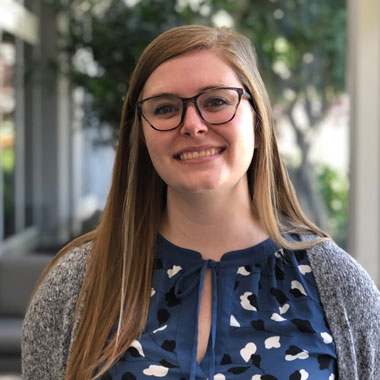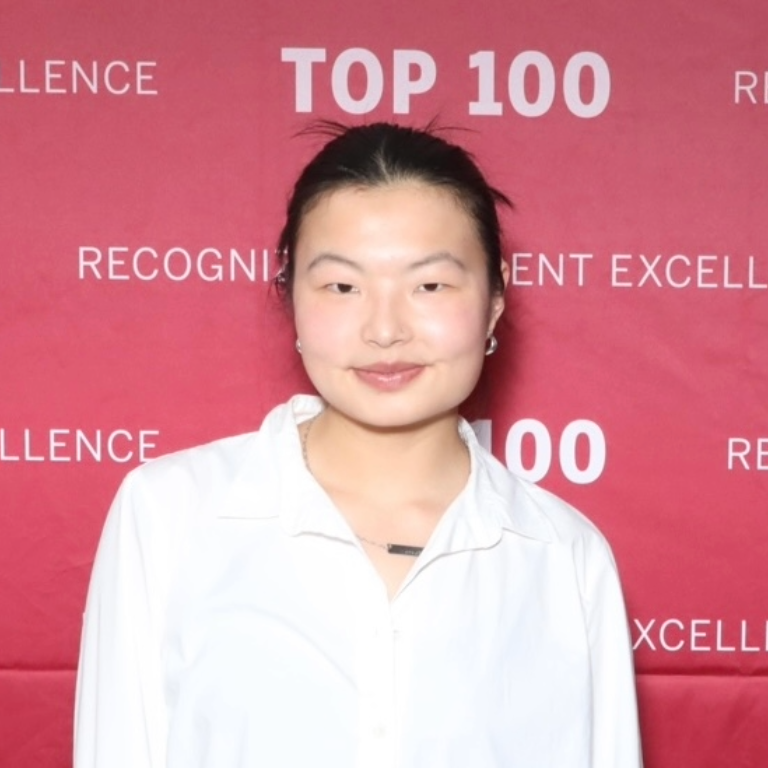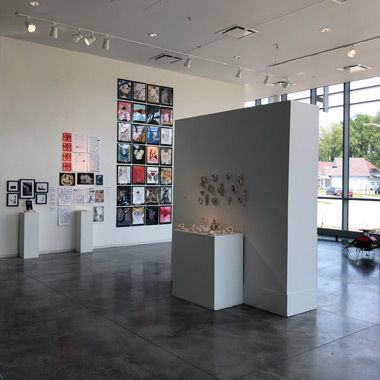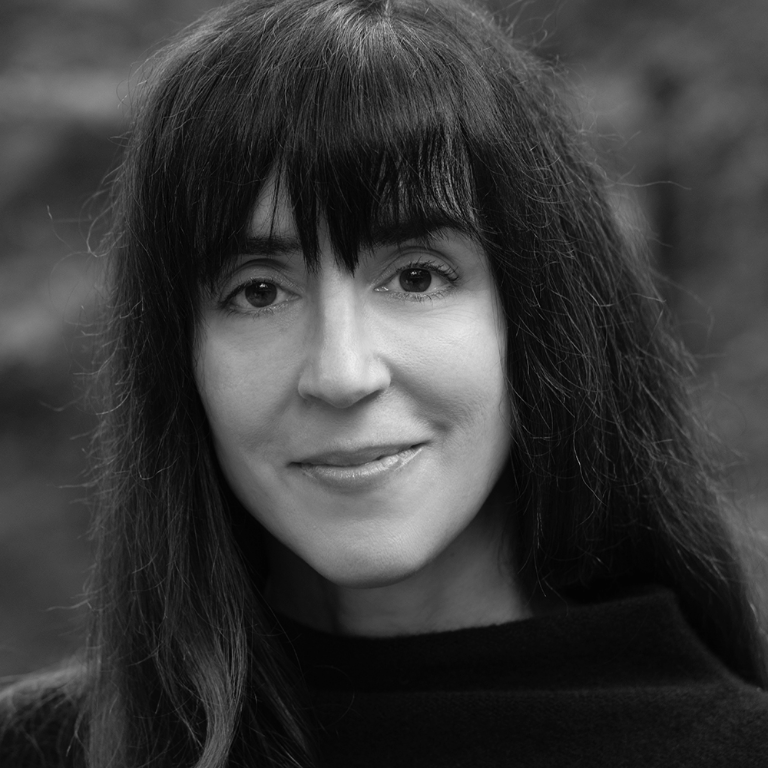This Q&A is part of a series about Herron's Distinguished Alumni Award recipients, their careers, and the impact they've had on their communities through exceptional practice and/or dedication to the school.
Kaitlin Knapp (M.A. Art Therapy '17), the clinical program manager at Ascension St. Vincent and Peyton Manning Children's Hospital, was just awarded the 2021 Distinguished Alumni Award. She is recognized for her outstanding commitment to expanding creative arts therapies, advocating for an Art Therapist License through Indiana's Behavioral Health and Human Services Licensing Board, and connecting Herron's rising art therapists to opportunities in central Indiana.
Read on to learn more about Knapp's work as a board-certified art therapist and licensed mental health counselor.
HERRON: Let's start with your backstory. What originally piqued your interest in becoming an art therapist?
KAITLIN KNAPP: I was studying to be an art teacher in college, which required a number of studio art and psychology courses, both of which I was interested in. While planning my next steps after graduation, I found Herron's master's degree program and decided to explore other ways art and psychology can be used in tandem outside of education.
HERRON: What words would you use to describe your approach to healing?
KNAPP: The arts are inherently healing and life-enhancing, whether you are a novice meeting doodler or a professionally trained fine artist, so I suppose I would say creative, holistic, and inclusive.
HERRON: What are some of the aspects of being an art therapist that many people, including patients, overlook?
KNAPP: It's not always about the final product. When I first introduce myself as an art therapist, many of the patients and staff I work with immediately respond with, "Well, I haven't done art since elementary school" or "I can't draw a straight line with a ruler."
Art therapy is so much more than just creating something pretty that we are proud of, it can look like living in the messy moments and truly experiencing emotions in an abstract way. This allows people a chance to explore their thoughts and feelings in a new way that does not always require words, which can be difficult for many people.
HERRON: You developed the Ascension St. Vincent Healing Arts Program in 2017, which integrates services at Ascension St. Vincent Hospital, the Ascension St. Vincent Stress Center, and Peyton Manning Children's Hospital. You have also participated in hospital-wide initiatives to increase creative arts therapies in the hospital, such as the Healing Arts Gallery. What is the primary motivator behind these efforts?
KNAPP: By expanding and introducing new projects to the entire hospital, whether it is by a Creative Arts Therapist at the bedside or local artwork displayed in the hallways, we are working to show our patients and the community that you are more than your diagnosis.
We are all unique in our approaches to healing and experiencing wellness, so by incorporating creative Arts therapies into bedside care more broadly and increasing people's exposure to the arts, we are attempting to meet people where they are.
HERRON: What do you love most about your job?
KNAPP: I love how no two days are the same. Working as a clinical program manager, I get to collaborate with a variety of departments ranging from quality and safety to facilities to surgery to administration, and more. And being a creative arts therapist, I have the opportunity to explore new ways to include the arts into traditional health care.
HERRON: You co-chaired a governmental affairs committee to submit licensure for Senate Bill 46, which would allow the Indiana Behavioral Health and Human Services Licensing Board to license professional art therapists and art therapist associates. What is the bill's central issue?
KNAPP: Art therapists work with vulnerable populations, including people who are diagnosed with mental health disorders, medical illnesses, substance abuse, veterans, and others who have been exposed to violence and trauma. However, there are no requirements under Indiana law that art therapists be qualified to perform and practice such treatment and assessment. This law will ensure that all art therapists and those who provide art therapy have the proper training.
With increased awareness of the vast array of benefits provided by art therapy, more consumers prefer that non-threatening approach but are unable to access these services due to a lack of availability. Indiana residents deserve the best care available, as well as the assurance that those facilitating art therapy services are licensed.
HERRON: What is the bill's current status? Have there been any recent developments?
KNAPP: Currently, we are planning our 2022 General Assembly action plan, figuring out how to keep advocating for our profession and educating local leaders so that the need for this bill is understood and well received when it comes to the floor. The third time's the charm!
HERRON: Your master's thesis was about the neuroscience of creative arts and developing a scientific understanding of the cognitive process involved in making art. What did you learn while working on the research team as a result of the study?
KNAPP: As a team, we confirmed that creativity is a whole-brain process, not just the right side of the brain. One of the more unexpected findings was in relation to a participant's level of previous experience with art and the amount of brain activity observed during the art-making process. When compared to participants who had formal art training, participants who had little to no experience making art showed more brain activity while creating. This was an exciting discovery, demonstrating the neurological benefits of creating art for people who "can't draw a straight line with a ruler."
HERRON: What key lessons did you learn at Herron?
KNAPP: One of the biggest lessons that I learned is to not take myself too seriously. In my experience, artists can be their own harshest critics. Herron's art therapy program taught me that we don't expect our patients or clients to be perfect, so why should we expect that of ourselves?
HERRON: You are constantly connecting Herron's aspiring art therapists to opportunities in the Indianapolis Metropolitan Area, on top of everything else you do as an art therapist and administrator in the hospital system. What inspires you to provide internships?
KNAPP: I began my career as a student intern at Ascension St. Vincent, which led to full-time employment and, later, management opportunities. I would not be where I am today if those in hospital leadership had not taken a chance on me. Seeing this firsthand has definitely influenced my drive to invest in the future of art therapy, its students, and new professionals.
HERRON: And you also serve on Herron's Art Therapy Advisory Board?
KNAPP: I joined the Advisory Board two years ago as an alumni member and have now accepted another term as an Indiana Art Therapy Association (IndiATA) delegate. What strikes me the most about this board is its willingness to listen and to adapt to the needs of their students.
HERRON: Do you have time to create when you're not working?
KNAPP: Yes! In addition to my own self-care (the flavor of the month is embroidery), I've found a group of art therapists who meet monthly to create art and experiment with new interventions. It's refreshing to create alongside like-minded therapists, introducing one another to new techniques and materials that will not only benefit us professionally, but also personally.
HERRON: What is the one question you wish we had asked, and what is your response?
KNAPP: "Where do you go from here?" In the near future, I hope to apply to a doctoral program to pursue a doctorate in health administration (D.H.A.) in order to broaden my understanding of hospital administration, policy, and procedure and further integrate and lead efforts for the inclusion of creative arts therapies in medicine.








